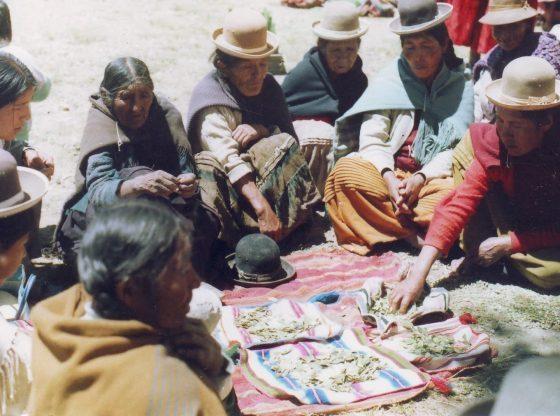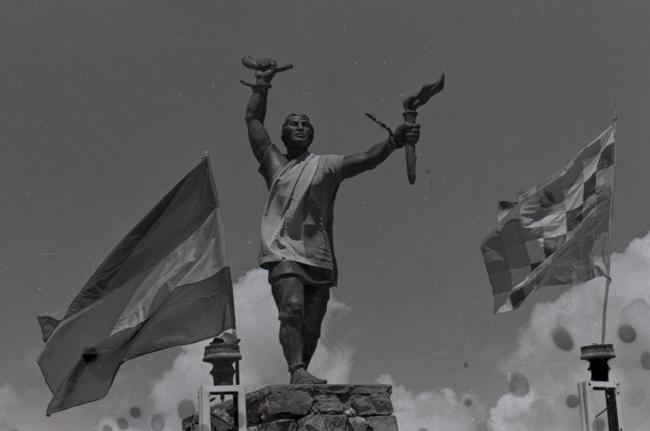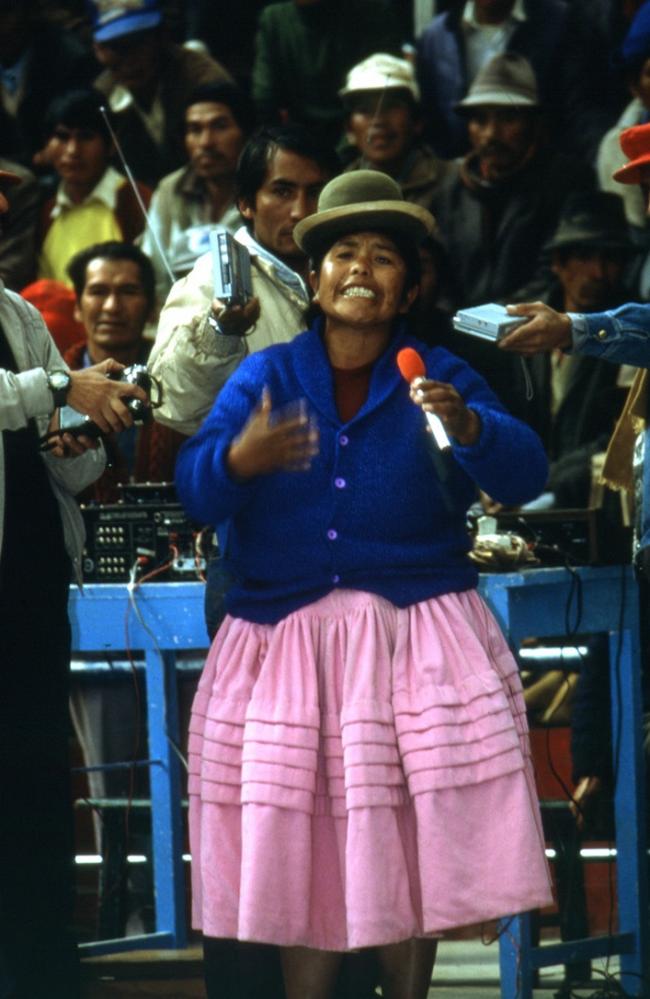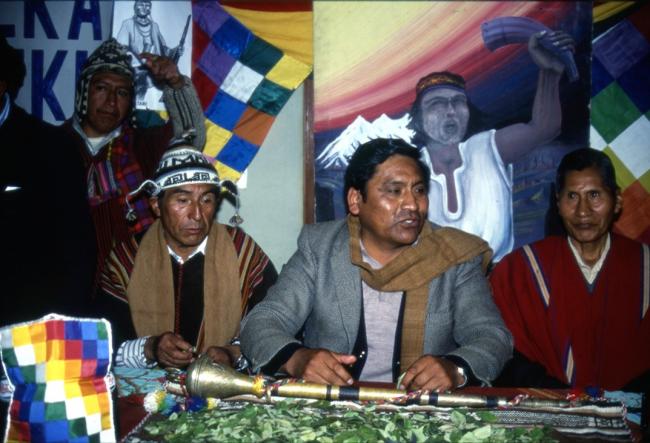
Grassroots people’s movements around the globe have wielded histories of resistance as tools in their struggles to build a better world. Some have drawn from the wellspring of oral history, putting forgotten uprisings back on the political map. Others have raised the portraits and words of their past heroes on placards and banners as they march down the streets of their cities. Together, these actions constitute a historical toolbox from below, a rebel memory.
Producing histories that emphasized the “unreported resistance” of Indigenous people, anti-slavery activists, and workers’ movements was a central approach of people’s historian Howard Zinn. “To omit these acts of resistance is to support the official view that power only rests with those who have the guns and possess the wealth,” Zinn wrote. “To think that history writing must aim simply to recapitulate the failures that dominate the past is to make historians collaborators in an endless cycle of defeat. If history is to be creative, to anticipate a possible future without denying the past, it should, I believe, emphasize new possibilities by disclosing those hidden episodes of the past when, even if in brief flashes, people showed their ability to resist, to join together, and occasionally to win.”
Such flashes of resistance are a key focus of my new book, The Five Hundred Year Rebellion: Indigenous Movements and the Decolonization of History in Bolivia. This work looks at the ways Bolivian Indigenous movements have used oral history, grassroots historical research, and the recovery of past political models and rebels to strengthen and orient their struggles, and transform Bolivian politics and society.
The work of these Indigenous movements has been part of a larger international project of decolonization and liberation. Indeed, movements all across Latin America have utilized the past to build bonds between communities and strengthen movements’ claims and legitimacy.
The history of Augusto Sandino, who fought a guerilla war in Nicaragua from 1927 to 1933, was recovered by the Nicaraguan thinker Carlos Fonseca in the intellectual building of the Sandinista National Liberation Front (FSLN). In the 1970s, Fonseca and others wove Sandino into the revolutionary ideology of the FSLN, elevating the guerilla leader as a guiding and empowering symbol of their movement. Sandinistas “worked on” the history of Sandino, pulling him out of obscurity and into the trajectory of the FSLN, which positioned itself as the rightful heir of Sandino’s legacy and unfulfilled struggle.
The Zapatistas in Chiapas, Mexico appropriated the figure of Mexican Revolution leader Emiliano Zapata as their own symbol of struggle and positioned Maya peoples as protagonists, rather than victims, united through a pan-Mayan identity.
The first Zapatista declaration from the Lacandon Jungle in 1994 began with a reference to this past, placing the Zapatistas within a long arc of resistance: “We are a product of 500 years of struggle: first against slavery, then during the War of Independence against Spain led by insurgents, then to avoid being absorbed by North American imperialism, then to promulgate our constitution and expel the French empire from our soil. … We are the inheritors of the true builders of our nation.”
In Bolivia, Indigenous movements’ recovery and championing of histories of resistance increased their numbers and appeal, provided a lens to grapple with neocolonialism, and offered strategies and potent symbols for revolts. Their historical production and analysis fed into a collective vision for Indigenous liberation.
Last November, protesters in Bolivia organized massive road blockades demanding that Jeanine Áñez step down from office following what they viewed as a violent coup against President Evo Morales. Blockade leaders sought to cut off the cities, echoing Túpac Katari, who led a siege of Spanish-controlled La Paz in 1781 as part of a wider rebellion to put the Andes back under Indigenous rule.
Wielding Katari as a political symbol from the street barricades is part of a long tradition in Bolivia, a tradition that speaks to the power of the past as an instrument of struggle.

History as an Instrument of Struggle in Bolivia
The Five Hundred Year Rebellion focuses primarily on Aymara-based Indigenous movements and groups in the Andean highlands of Bolivia, largely in and around the capital city of La Paz. Aymara activists, leaders, and intellectuals in this region deployed striking productions and uses of history in movements and political thought. The book therefore focuses on how the Kataristas, the Unified Syndical Confederation of Rural Workers of Bolivia, the Andean Oral History Workshop, and the National Council of Ayllus and Markas of Qullasuyu drew from and produced histories and symbols to guide and strengthen their struggles.
Indigenous movements and intellectuals dramatically reshaped the political landscape of the country over Bolivia’s tumultuous twentieth century. The Kataristas, a group of Indigenous activists and intellectuals operating largely in La Paz in the wake of the 1952 National Revolution, helped launch an indigenous resurgence in the 1970s. They did so through manifestos, rural organizing efforts, and small publications that championed indigenous identity, historical consciousness, and the political model of past indigenous martyrs and preconquest utopias. The Kataristas sought to overturn what they saw as the paternalistic and racist yoke of state hegemony in the countryside and to forge an independent campesino union movement that served the needs and values of the indigenous majority.
One of the Kataristas’ greatest legacies was their role in the 1979 founding of the Unified Syndical Confederation of Rural Workers of Bolivia (CSUTCB), an Indigenous campesino union made up of small-scale farmers who promoted Indigenous culture and identity, and pressured government officials for access to land, technical and financial support, and a direct role in rural policy development. As part of their work, the CSUTCB produced and mobilized Indigenous histories through speeches, rallies, and political proposals. The CSUTCB highlighted the centuries-long roots of their struggle in public statements released in the midst of road blockade campaigns and they used blockade tactics that drew specifically from Katari. Their rhetorical and physical evocation of the eighteenth-century siege underscored the CSUTCB’s power as they toppled dictatorships and fought to revolutionize land reform.

The use of the past by these groups as a tool for mobilizing their members and fighting for social change was echoed in the work of the Andean Oral History Workshop (THOA), which was founded in 1983 by a group of primarily Aymara scholars and students who met at the Universidad Mayor de San Andrés in La Paz. The THOA used oral history practices to gather testimonies and produce pamphlets, books, and radio programs on little-known histories of Indigenous resistance. It then distributed these materials throughout the rural highlands. The THOA’s innovative research methods and accessible publications strengthened Indigenous historical consciousness and contributed to the rise of a new generation of Indigenous movements.
One of the THOA’s most influential historical productions was on the Indigenous rebel Santos Marka T’ula, a cacique apoderado, the title for leaders chosen by their communities to legally represent them in court and in government in defense of their rights and land claims. T’ula and other caciques apoderados fought large landowners’ dispossession of Indigenous lands in the early twentieth century. The THOA produced a booklet and nationally broadcasted radio program in Aymara on T’ula’s struggle, bringing the largely unknown history of the caciques apoderados to life.

The THOA expanded its work in the 1990s by accompanying the National Council of Ayllus and Markas of Qullasuyu (CONAMAQ) and its effort to reconstitute and strengthen Bolivia’s ayllus, a centuries-old form of community organization in the Andes. Key ayllu traditions that survived over the centuries include systems of rotational leadership, ethics of mutual aid, communal labor organization, and archipelago-like agricultural production spanning various ecological zones in the Andes. The CONAMAQ and ayllu activists, with the help of the THOA, conducted their own historical research on ayllu history, principles, traditions, and customs, which led to the development of a national network of ayllus that collaborated to promote Indigenous and ayllu community rights, autonomy, and political power.
In the midst of this process of ayllu reconstitution, the Bolivian government pushed forward a series of neoliberal policies that undermined workers’ rights and unions, privatized services and resources, and enacted austerity measures. This economic overhaul of the country led to a wave of protests in the early 2000s. The ayllu networks, along with many other Indigenous organizations, unions, neighborhood councils, and social movements, filled the streets in uprisings that overturned the neoliberal model in Bolivia and led to the election of Bolivia’s first Indigenous president, Evo Morales, in 2005.
At the start of the twenty-first century, protesters resisting corporate globalization and state repression once again raised the symbol of Katari at the barricades, renewing the legacy of his eighteenth-century siege. Under President Morales, Indigenous histories, symbols, and consciousness gained more prominence through the rewriting of the country’s constitution, rescuing the model of the ayllu and Indigenous justice, championing a state-led process of decolonization, and elevating the works of prominent Indigenous historians and thinkers. The seeds of these twenty-first-century political uses of the past can be traced back to centuries of Indigenous movement organizing in the Andes.
Andean Utopias and Memories of Rebellion
These Bolivian Indigenous movements deployed shared visions of history in their speeches, organizational rituals, and collective actions that united movement members in their efforts toward a common goal.
This historical work helped to “bring the group together, legitimate their actions, identify their opponents and define their demands,” according to research by Bolivian social movement scholars Álvaro García Linera, Marxa Chávez León, and Patricia Costas Monje. For these movements, a past struggle—most notably that of Katari—did not simply exist statically in history but served as a “productive symbolic force” for the future as well, something that could return through action in the present. In this way, “the past is living history which pushes toward the fulfillment of an emancipated future.”
A “memory of rebellion” constantly guides the movements’ identities, actions, and goals. “This memory,” the authors write, “is permanently ritualized” in speeches, banners, placards, portraits of historical rebels in marches, and posters in movements’ offices, as well as demands and manifestos.

Sacred sites, symbols, and rituals have also oriented collective memory and identity during moments of Indigenous rebellion, according to sociologist Pablo Mamani. The birthplace of Katari, the geographic site of his siege in El Alto, checkered rainbow wiphala flags (representing Indigenous nations of the Andes), pututo horns, and banners of Indigenous martyrs all help Indigenous activists “define who we are,” Mamani writes. Activists’ assertion of indigenous identity also helps to strengthen the wider Indigenous community as a basis for mobilization, as well as to counter government denigration of Indigenous people and culture.
These movements notably used the idea of a preconquest Andean utopia as tools in their struggles. Bolivian Indigenous philosophers championed the recovery of this civilization in their postrevolutionary writings and political propaganda. Kataristas called for a return to preconquest ideals and knowledge in their 1973 Manifesto of Tiwanaku. The CSUTCB aimed to implement ancient Indigenous agricultural models in their 1984 proposal for agrarian reform. Similarly, the ayllu reconstitution efforts of the 1990s sought to rescue and strengthen traditions of communal governance and labor organization that predated the Incan empire.
Dreams of a return to a preconquest utopia were based on historical facts with concrete names and places, such as the crushed Incan civilization and the network of surviving ayllus, which had historically spanned the region.
When the concept of an Andean utopia was recovered for a renewed vision of the future among Indigenous people in Peru during the colonial period, Peruvian scholar Alberto Flores Galindo writes, “the ideal city did not exist outside history or at the remote beginning of time. On the contrary, it was a real historic fact that had a name [Tawantinsuyo—the Incan empire], and a ruling class (the Incas); and a capital (Cuzco). Andean people changed the particulars of this construction to imagine a kingdom without hunger, without exploitation, and where they ruled once again. It represented the end of disorder and darkness. Inca became an organizing idea or principle.”
“For people without hope,” Galindo continues, “the Andean utopia challenges a history that condemned them to the margins .”
Such political uses of the past have been renewed throughout five hundred years of resistance, in marches and road barricades, manifestos and radio programs, by Indigenous rebels mobilizing history to change the future.
Originally published in Abusable Past.
Dr. Benjamin Dangl teaches journalism as a Lecturer of Public Communication in the Department of Community Development and Applied Economics at the University of Vermont. He has worked as a journalist throughout Latin America. His most recent book is The Five Hundred Year Rebellion: Indigenous Movements and the Decolonization of History in Bolivia (AK Press).

